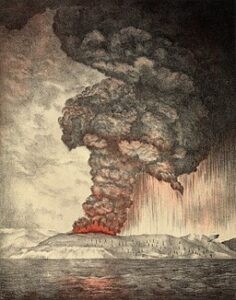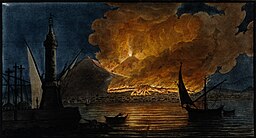“I looked when He opened the sixth seal, and behold, there was a great earthquake; and the sun became black as sackcloth of hair, and the moon became like blood. And the stars of heaven fell to the earth, as a fig tree drops its late figs when it is shaken by a mighty wind. Then the sky receded as a scroll when it is rolled up, and every mountain and island was moved out of its place.
And the kings of the earth, the great men, the rich men, the commanders, the mighty men, every slave and every free man, hid themselves in the caves and in the rocks of the mountains, and said to the mountains and rocks, ‘Fall on us and hide us from the face of Him who sits on the throne and from the wrath of the Lamb! For the great day of His wrath has come, and who is able to stand?'” (Revelation 6:12-17).
 18 May, 1980, witnessed the cataclysmic eruption of Mount St. Helens, a volcanic mountain in the western United States. Triggered by an earthquake that registered at 5.1 on the Richter scale, the lateral blast emanating from the mountain’s northern flank ripped through the surrounding landscape at an astonishing speed of 300 miles per hour (483 kph). That eruption produced a 230 square mile (370 square km) periphery of devastation that extended 17 miles (27 km) from the crater. It also produced a vertical eruption of gas and ash that reached 16 miles (26 km) into the atmosphere. 57 people lost their lives in the devastation that followed. (1)
18 May, 1980, witnessed the cataclysmic eruption of Mount St. Helens, a volcanic mountain in the western United States. Triggered by an earthquake that registered at 5.1 on the Richter scale, the lateral blast emanating from the mountain’s northern flank ripped through the surrounding landscape at an astonishing speed of 300 miles per hour (483 kph). That eruption produced a 230 square mile (370 square km) periphery of devastation that extended 17 miles (27 km) from the crater. It also produced a vertical eruption of gas and ash that reached 16 miles (26 km) into the atmosphere. 57 people lost their lives in the devastation that followed. (1)
 In the late 1800s, the Indonesian island of Krakatoa experienced a volcanic eruption that ranks among history’s most catastrophic natural disasters. Krakatoa’s eruption in August, 1883, generated devastating tsunamis up to 130 feet (40m) high. In its final stages, the noise produced by the exploding volcano was heard thousands of miles away in Australia. The immense power of the volcano’s eruption resulted in the near-total destruction of Krakatoa, along with several nearby islands. It also led to an estimated death toll of more than 36,000 people. (2)
In the late 1800s, the Indonesian island of Krakatoa experienced a volcanic eruption that ranks among history’s most catastrophic natural disasters. Krakatoa’s eruption in August, 1883, generated devastating tsunamis up to 130 feet (40m) high. In its final stages, the noise produced by the exploding volcano was heard thousands of miles away in Australia. The immense power of the volcano’s eruption resulted in the near-total destruction of Krakatoa, along with several nearby islands. It also led to an estimated death toll of more than 36,000 people. (2)
 Many centuries earlier, in 79 A.D., the eruption of Mount Vesuvius devastated the ancient Roman cities of Pompeii and Herculaneum in southern Italy. A deluge of volcanic ash and pumice stones engulfed those urban areas, prompting many residents to flee and others to seek shelter. Those who remained in Pompeii were subsequently killed when a cloud of toxic gas engulfed the city. Today, one can tour the architectural ruins of Pompeii and view casts taken of some of those individuals as they faced their final moments of life. (3)
Many centuries earlier, in 79 A.D., the eruption of Mount Vesuvius devastated the ancient Roman cities of Pompeii and Herculaneum in southern Italy. A deluge of volcanic ash and pumice stones engulfed those urban areas, prompting many residents to flee and others to seek shelter. Those who remained in Pompeii were subsequently killed when a cloud of toxic gas engulfed the city. Today, one can tour the architectural ruins of Pompeii and view casts taken of some of those individuals as they faced their final moments of life. (3)
These historical accounts should thus encourage us to approach our text from Revelation 6:12-17 with reverence and seriousness as we seek to honor God with our lives today.
(1) The Editors of Encyclopaedia Britannica. (2024, November 17). Mount Saint Helens | Location, eruption, Map, & Facts. Encyclopedia Britannica. https://www.britannica.com/place/Mount-Saint-Helens Image Attribution: U.S. government, Public domain, via Wikimedia Commons
(2) Roller, S. (n.d.). 10 Facts About the Eruption of Krakatoa. History Hit. https://www.historyhit.com/facts-about-the-eruption-of-krakatoa/ Image Attribution: Lithograph: Parker & Coward, Britain;, Public domain, via Wikimedia Commons
(3) Sullivan, M. (2024, August 23). Mount Vesuvius erupts. HISTORY. https://www.history.com/this-day-in-history/vesuvius-erupts Image Attribution: See page for author, CC BY 4.0, via Wikimedia Commons

